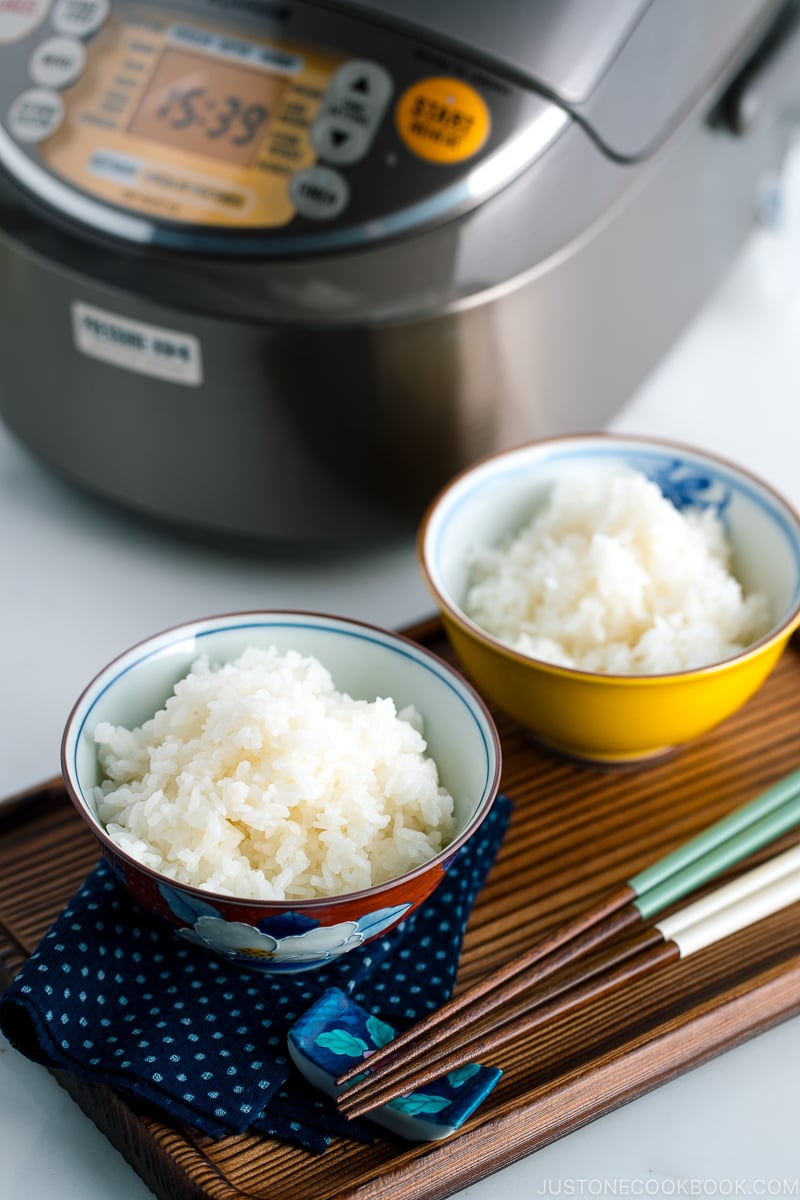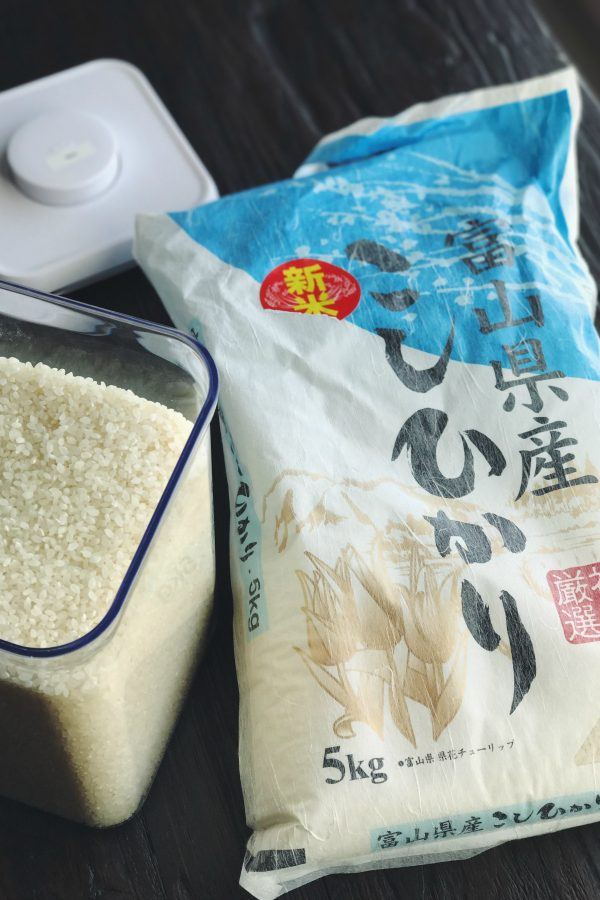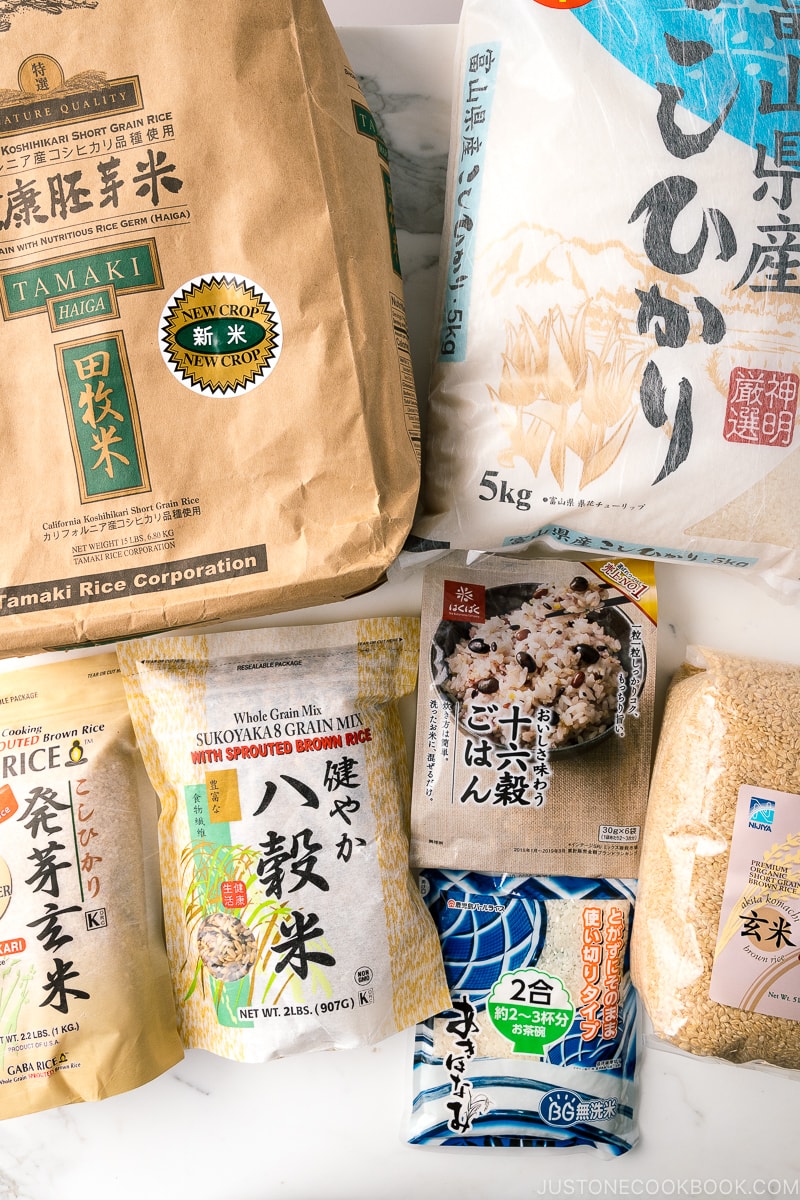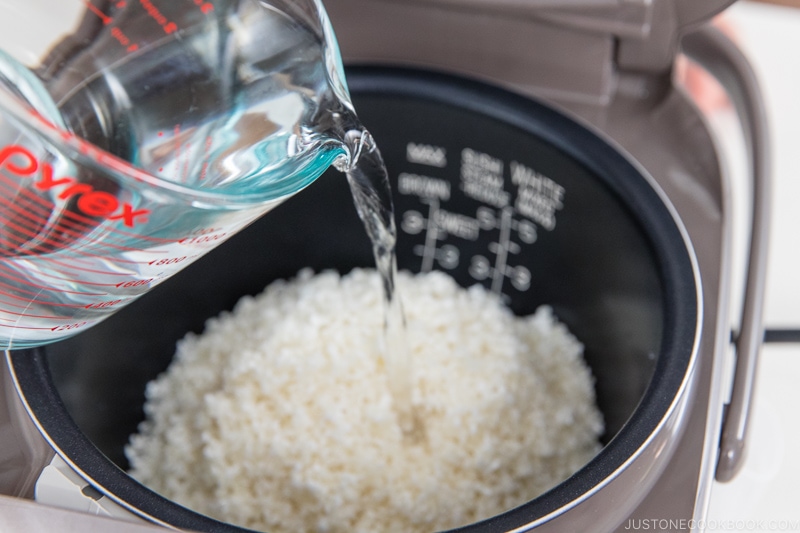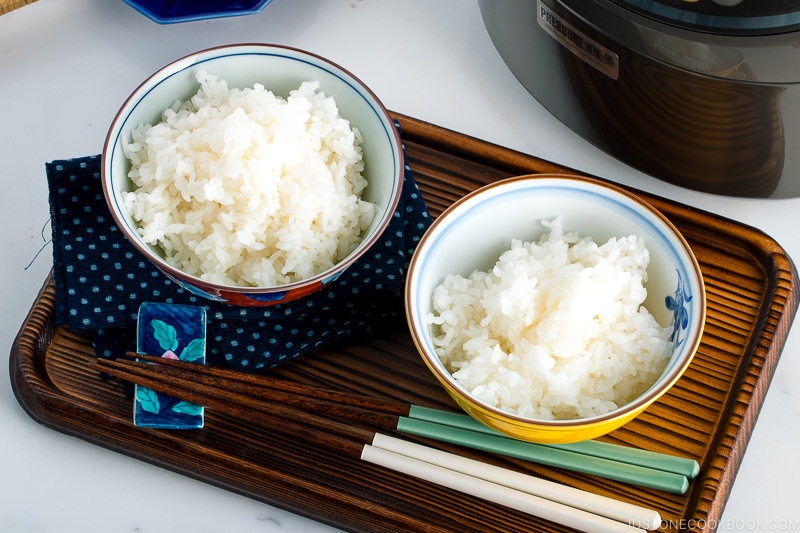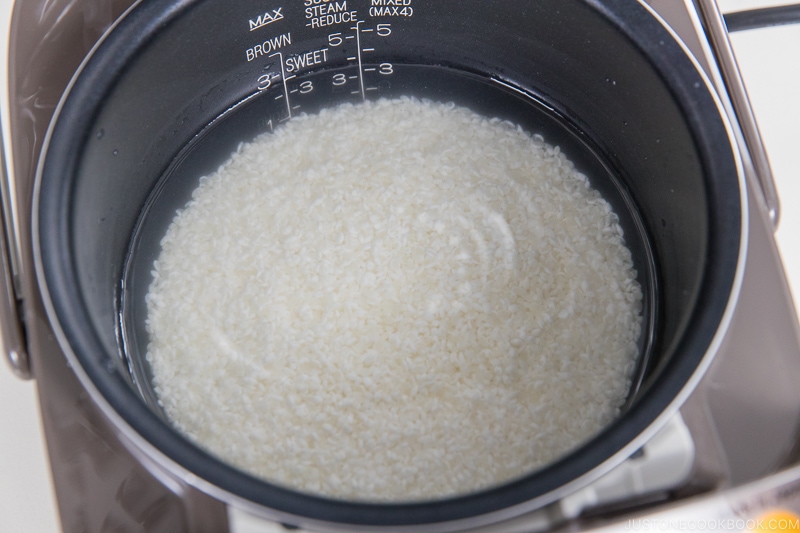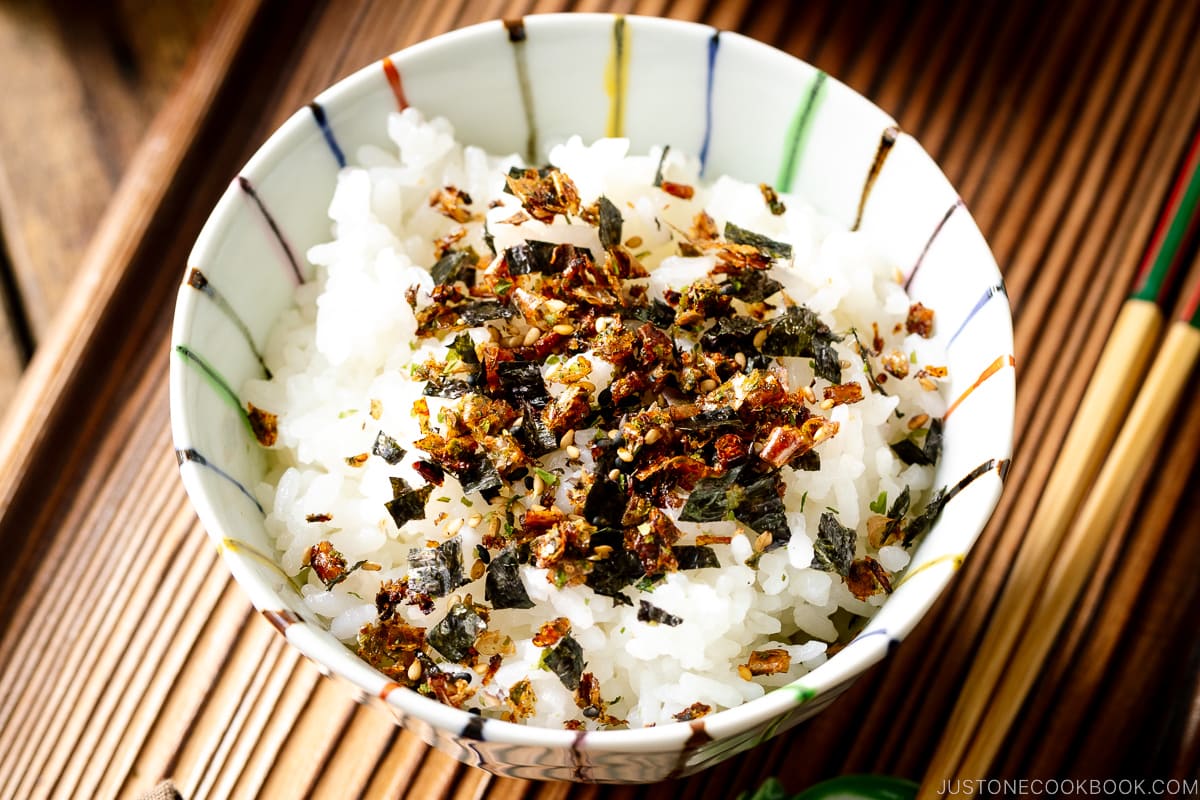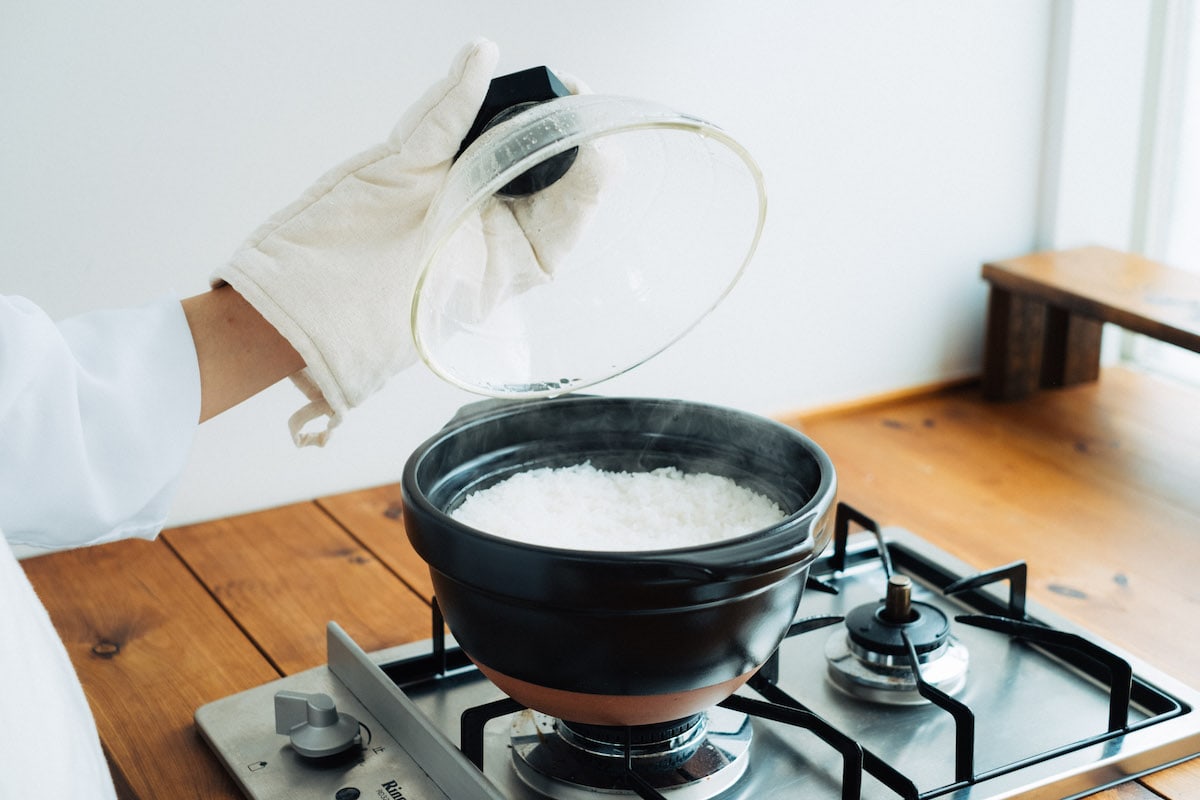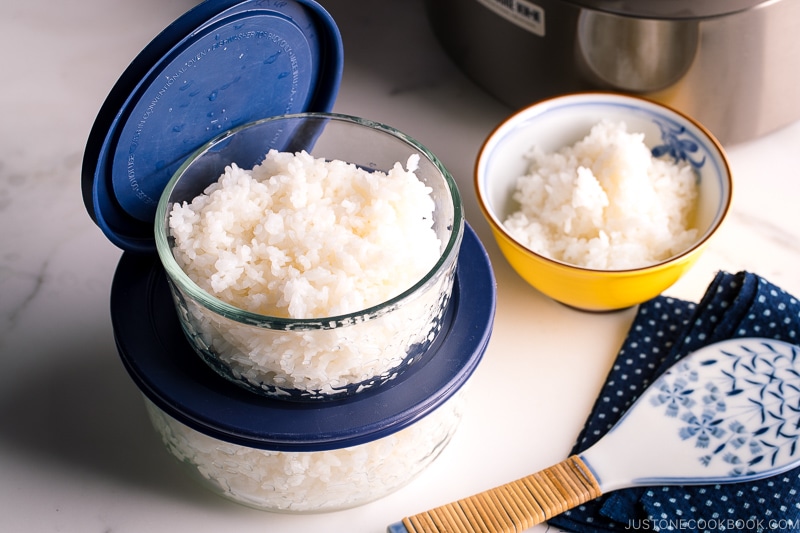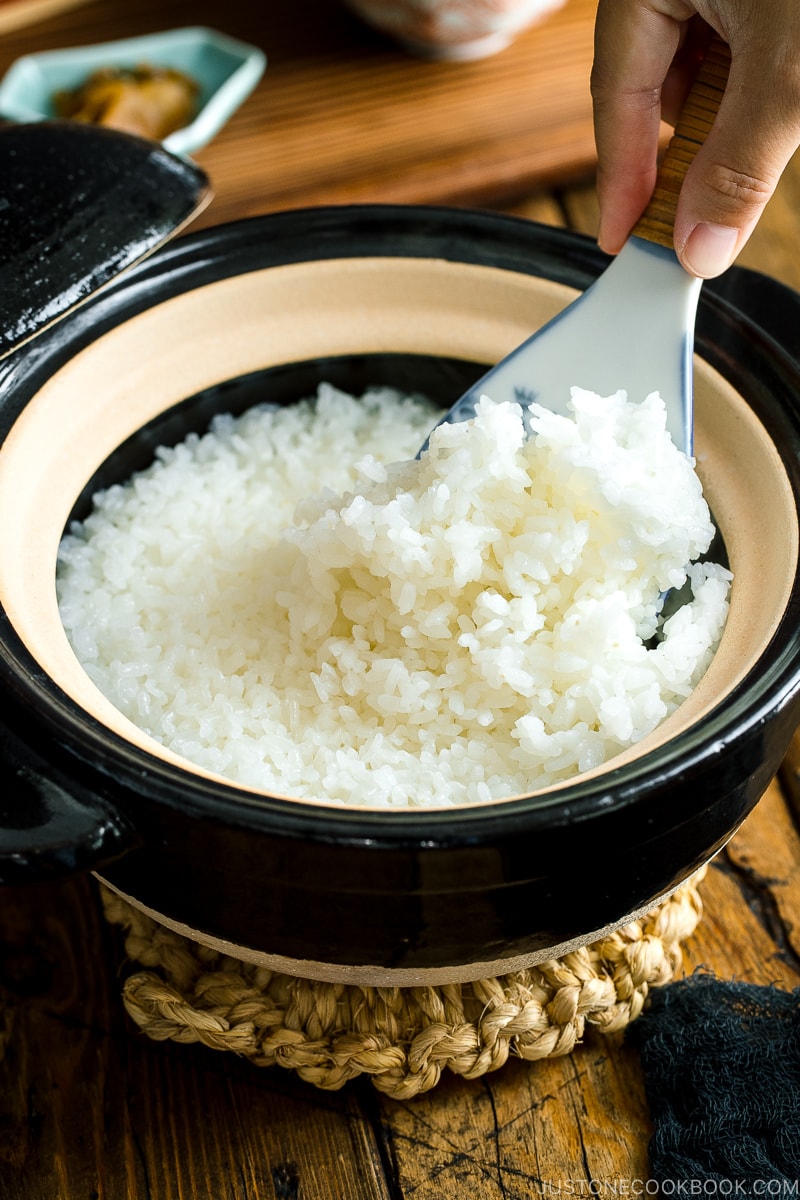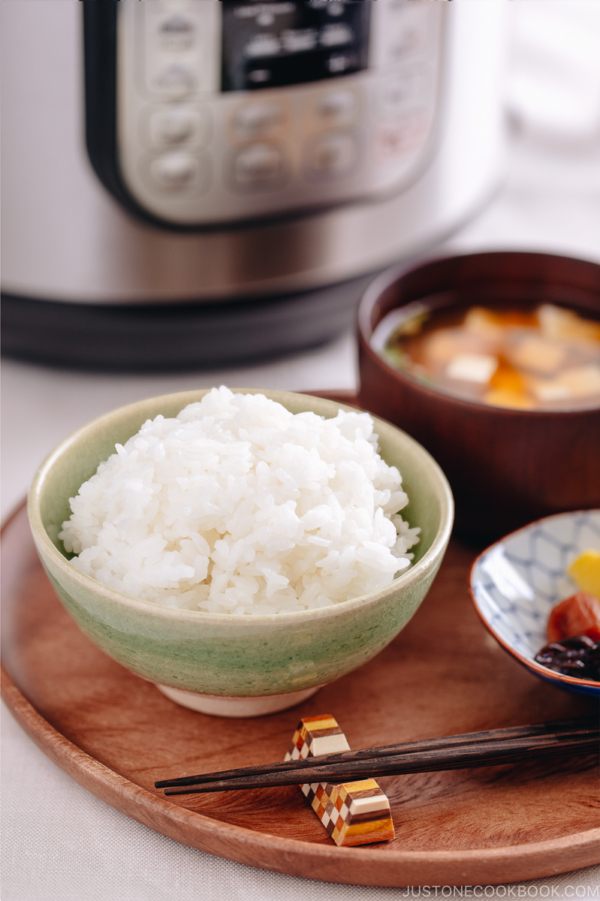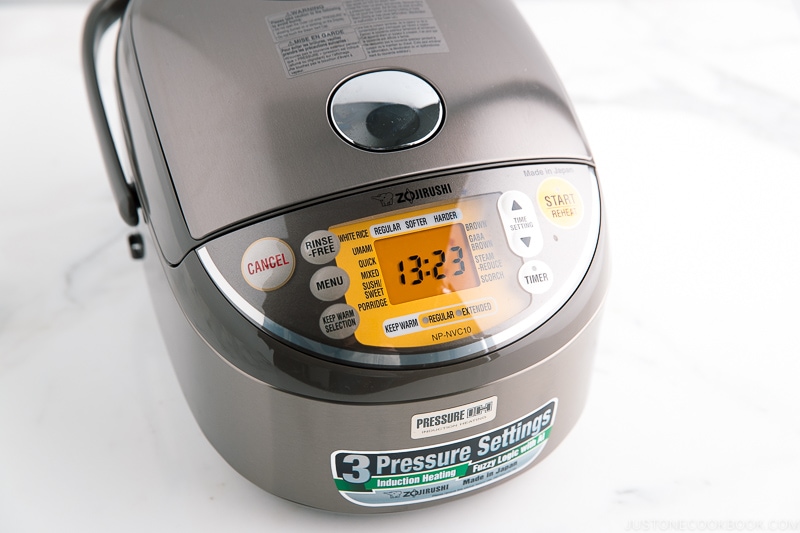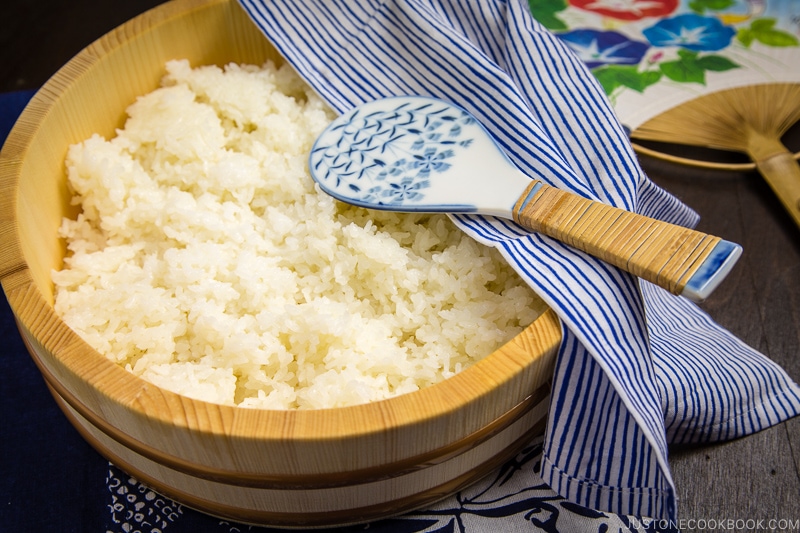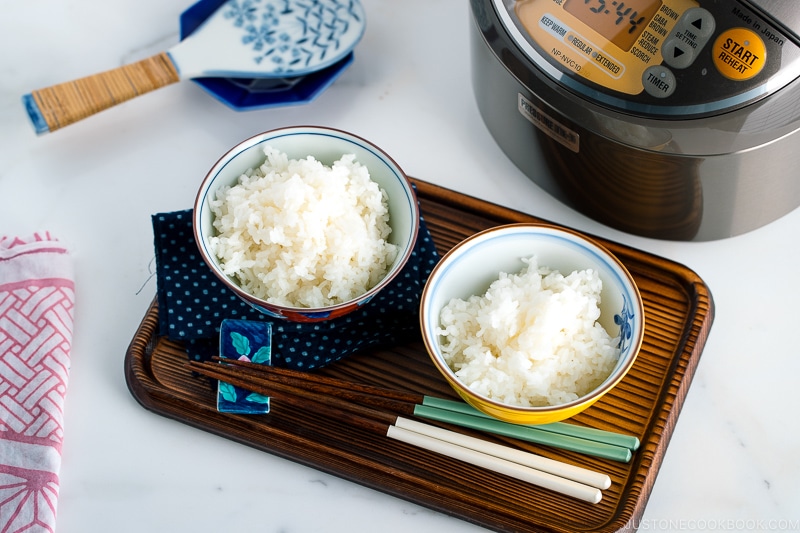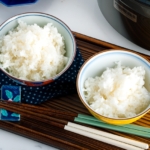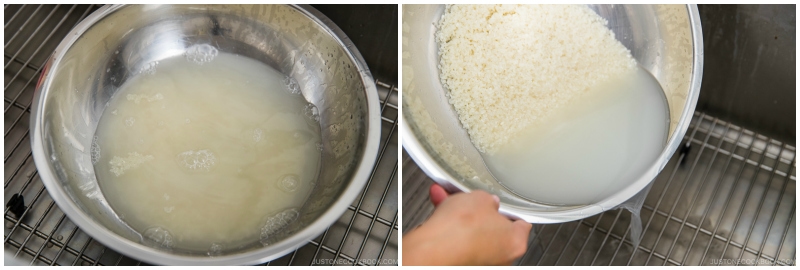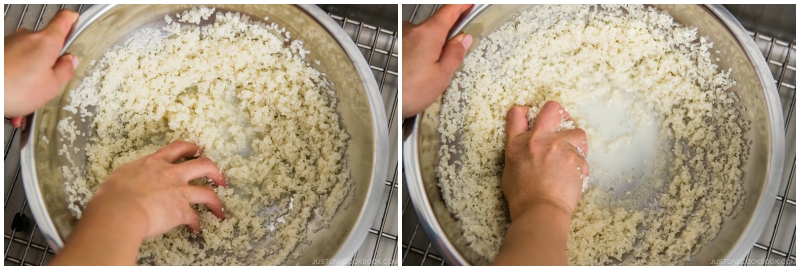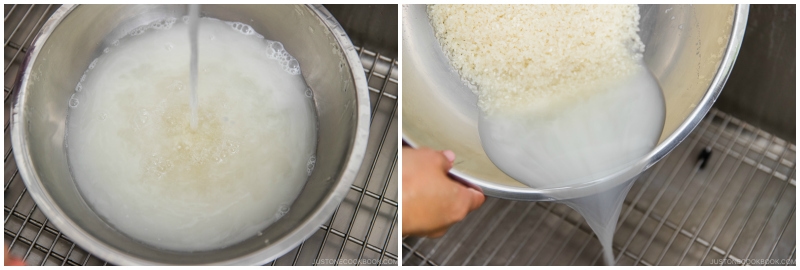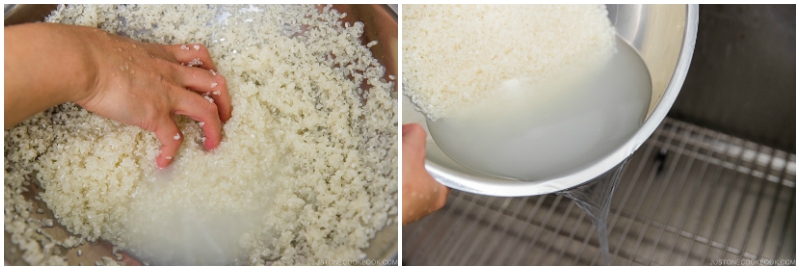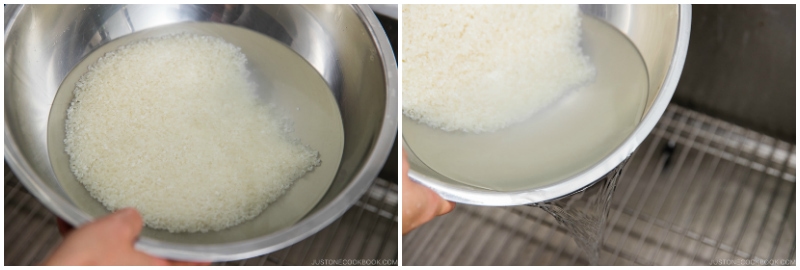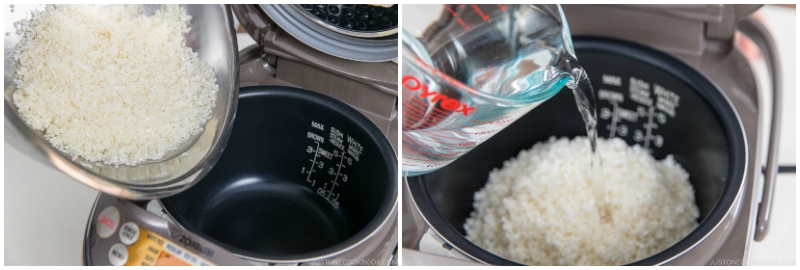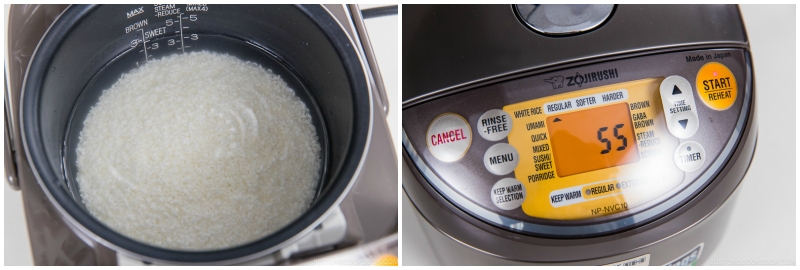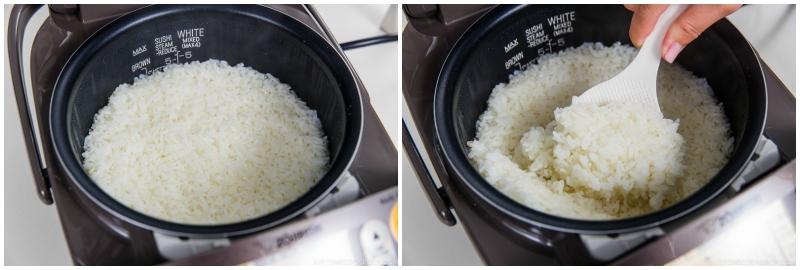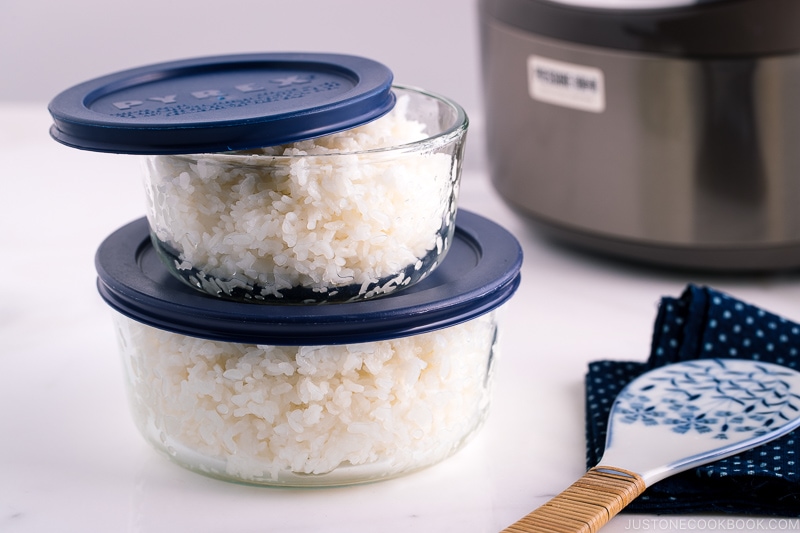The Japanese eat rice almost every day, sometimes 3 meals a day! Cultivated for thousands of years in Japan, rice occupies a significant place in the culture and is the quintessential staple of the Japanese diet. When it comes to the quality of the rice down to the cooking technique, we take every aspect seriously. Today I will share how the Japanese cook white rice in a rice cooker. We also have a recipe for cooking rice on the stove.
What is Japanese Short-Grain Rice?
Japanese white rice is a type of Japonica short-grain rice that is short, plump, and rounded oval. In general, Japanese rice has a higher water content compared to long-grain varieties like basmati or jasmine rice. This means that Japanese rice is more tender and moist. It‘s also more sticky and chewy because the grains contain less amylose—a type of starch that separates rice grains—than the long-grain type of rice. It’s worth noting that outside of Japan, Japanese short-grain rice is often called “sushi rice” for marketing purposes. In reality, Japanese rice is typically used in everyday meals and less often in sushi recipes. You may also notice that Japanese short-grain rice is incorrectly called “sticky rice.” Sticky rice is actually another name for glutinous rice or short-grain Japanese mochigome that has a completely different texture. We use this type of glutinous rice to make Mochi, Sekihan, and Okowa. 👉🏻 To brush up on your knowledge, I highly recommend reading “Everything You Need To Know about Japanese Rice” and “Types of Japanese Rice.“
My Favorite Japanese Rice Brands
When it comes to high-quality Japanese rice, I would recommend the koshihikari variety, which is available from various brands at Japanese grocery stores. Known for its sweet taste and fragrance, it is the most popular variety in Japan. My family particularly likes koshihikari rice imported from Toyama prefecture (blue and white package).
The Right Rice-to-Water Ratio for Short-Grain White Rice
Over the years, I’ve received a lot of questions from my readers asking why their rice comes out dry. It’s likely because most online resources (in English) will tell you the rice-to-water ratio for Japanese short-grain white rice is 1 to 1. But what you probably didn’t know is this: The Japanese golden ratio for white rice to water is 1 to 1.1 (or 1.2) by volume. That is 10–20% more water that you didn’t add! For example, one rice cooker cup (180 ml or ¾ US cup) of uncooked short-grain white rice will need 200 ml of water, not 180 ml. Note: If you still want to use a 1-to-1 ratio, you must soak the rice in separate water for 20–30 minutes (to absorb an extra 10–20% of water) and drain it well before you measure water at a 1-to-1 ratio. This way, you made sure your rice gets the moisture it needs. Most recipes online also do not include that soaking step, which means the rice is missing the additional 10–20% of water. Please note that the rice-to-water ratio is different for Japanese short-grain brown rice. To learn more, see my post How to Cook Short-Grain Brown Rice in a Rice Cooker.
How Much Water Do I Add for Japanese White Rice?
So… Exactly how much water do you need for each rice cooker cup? The plastic rice cooker cup that comes with the rice cooker is ¾ cup (180 ml). In Japan, this amount is called ichi go (一合). Here’s how much room-temperature water you need to add when you follow the 1-to-1.1 (or 1.2) ratio: 1 rice cooker cup (180 ml) = add 200 ml or ⅞ US cup of water2 rice cooker cups (360 ml) = add 400 ml or 1⅔ US cups of water 3 rice cooker cups (540 ml) = 600 ml 4 rice cooker cups (720 ml) = 800 ml5 rice cooker cups (900 ml) = 1000 mlCalculation: 180 ml x 1.1 (or 1.2) = 198 ml (or 216 ml) Most Japanese rice cookers have a setting for white rice. If yours does, the inner pot will have marked lines for how much water to add for the number of rice cooker cups that you’re cooking. In this case, you can simply add your rinsed and washed white rice to the pot and pour water to the marked line. My family and I actually prefer to add a bit more water than the water line in the rice cooker bowl for the imported Japanese rice we typically buy. Whenever we cook the rice according to the specified water line, the rice comes out a bit too dry. So, I highly encourage you to test and adjust the water amount whenever you switch the rice brand or the region where the rice is harvested.
Ingredients You’ll Need
Japanese short-grain white rice water (at room temperature)
How to Cook Japanese Short-Grain White Rice
How Much Rice Do I Need to Cook?
1 rice cooker cup (180 ml, ¾ cup, 150 g) of uncooked short-grain white rice 2¼ cups or 330 g of cooked rice 2 rice bowls 3 onigiri rice balls 1 donburi bowl 2 rice cooker cups (360 ml, 1½ cups, 300 g) of uncooked rice 4⅓ cups, 660 g of cooked rice 4 rice bowls 6 onigiri rice balls 2.5 donburi bowls 3 rice cooker cups (540 ml, 2¼ cups, 450 g) of uncooked rice 6⅔ cups or 990 g of cooked rice 6 rice bowls 9 onigiri rice balls 4 donburi bowls 4 rice cooker cups (720 ml, 3 cups, 600 g) of uncooked rice 8¾ cups or 1320 g of cooked rice 8 rice bowls 12 onigiri rice balls 5 donburi bowls 5 rice cooker cups (900 ml, 3¾ cups, 750 g) of uncooked rice 11 cups or 1650 g of cooked rice 10 rice bowls 15 onigiri rice balls 6 donburi bowls
Cooking Tips for Japanese White Rice
Always rinse and wash the rice. We always quickly rinse and wash the rice a few times. This is important to help remove impurities and the natural occurrence of arsenic on the rice. Short-grain rice always requires soaking (20–30 minutes), unlike other kinds of rice. The rice grains are rounder and fatter, so they need a head start to absorb moisture to the core of the kernel. Let the cooked rice steam for 10 minutes when the rice cooker turns off. Steaming is essential! It’s the final step in cooking Japanese rice. Without it, your rice will not cook fully. You can skip this step if your rice cooker program already includes 10 minutes of steaming time. Resist the urge to peek under the lid during this time! If you open the lid, you’ll release the precious steam that’s crucial for this resting period. When you use new crop rice (新米), reduce the water slightly. When you get a different brand of rice, test cooking the rice and adjust the amount of water, if needed The more rice you have in the pot, the more delicious your cooked rice will be. That’s because the most evenly cooked rice is in the center of the pot. The rice near the bottom and top simply cooks too fast. More rice in the pot means you’ll increase the central proportion of steamed rice for a more delicious outcome. That’s why I recommend cooking at least 2-3 rice cooker cups of uncooked rice at a time, even if you only need 1 cup. You can always freeze the extra rice with good results.
The Best Way To Store Cooked Rice
What’s the best method to store cooked rice? Simply freeze the rice in airtight containers and reheat to enjoy later on! This is by far the best approach to keeping your rice fresh and moist.
One cup of cooked white rice weighs 5.3 oz (150 g). A typical rice bowl serving is 1 cup (150 g) of cooked white rice. A typical donburi bowl serving is 1⅔ cups (250 g) of cooked white rice. A typical onigiri (rice ball) weighs 110 g each.
Other Methods of Cooking Japanese Short-Grain Rice
How to Cook Japanese Rice in a Pot on the Stovetop How to Cook Rice in an Instant Pot How to Cook Rice in a Donabe (Japanese Earthenware Pot) (for both white and brown rice) How to Cook Short-Grain Brown Rice in a Rice Cooker Instant Pot Brown Rice
My Favorite Rice Cooker
Those of us who live outside of Japan don’t have too many (fancy) choices. Since I came to the US, I’ve been using only Zojirushi brand rice cookers (3 of them). This is my current rice cooker by Zojirushi. It is a Zojirushi Pressure Induction Heating Rice Cooker & Warmer (5.5 cups). As we eat rice at home almost every single day, I depend highly on a superior-quality rice cooker to cook the perfect rice for my family. Zojirushi rice cooker uses pressurized cooking and AI (Artificial Intelligence) to cook rice. It also has a platinum-infused nonstick inner cooking pan that brings out the natural sweetness of the rice. The other features include:
Automatically selects from three pressure levels according to the menu selected Healthy cooking options: brown rice and GABA brown rice settings Menu settings include: white (regular, softer or harder), umami, mixed, sushi/sweet, porridge, brown, GABA brown, steam-reduce, scorch, rinse-free and quick cooking Made in Japan
Delicious Rice Recipes You’ll Love
How to Make Sushi Rice – you need sushi rice (seasoned rice) to make all kinds of sushi! Takikomi Gohan (Mixed Rice) – a traditional way to add flavor and nutrients to your rice 12 Donburi (Rice Bowl) Recipes – these are some of my favorite Japanese dishes! Onigiri (Japanese Rice Balls) Shrimp Fried Rice
I hope you’ve found the above tips helpful. I’ve also included more topics on rice after the recipe below. If you have more questions, leave me a comment below! Wish to learn more about Japanese cooking? Sign up for our free newsletter to receive cooking tips & recipe updates! And stay in touch with me on Facebook, Pinterest, YouTube, and Instagram.
